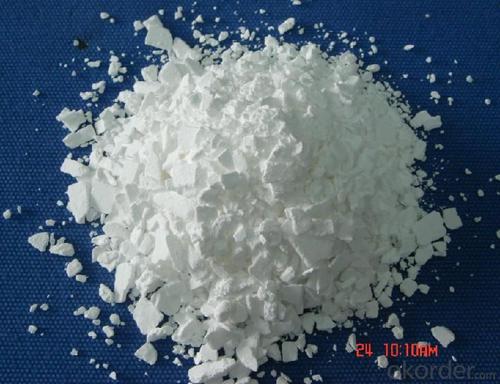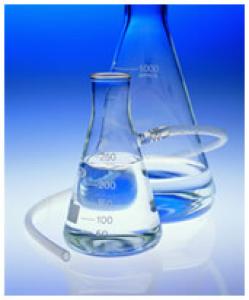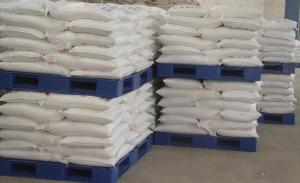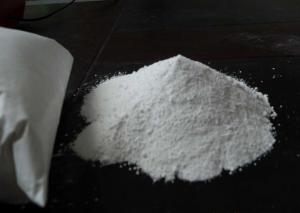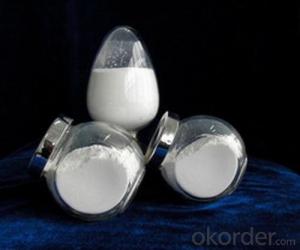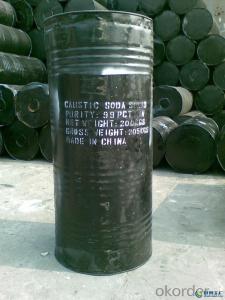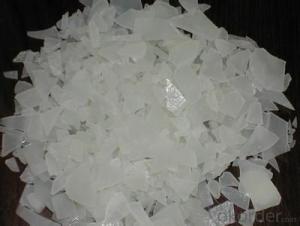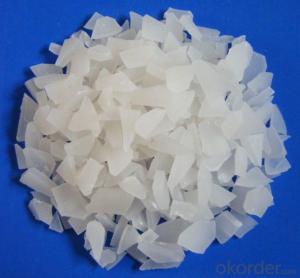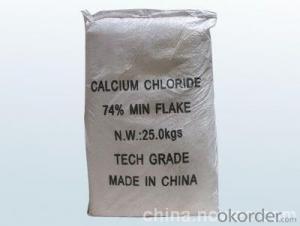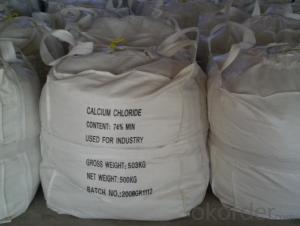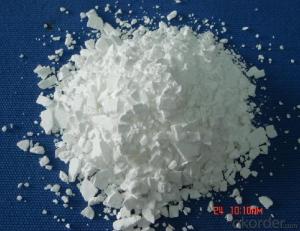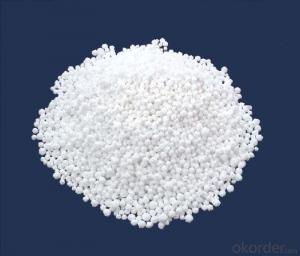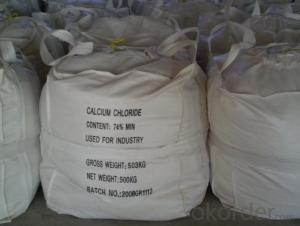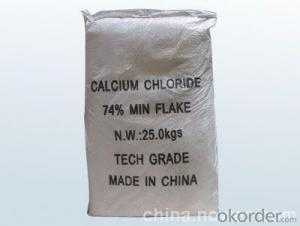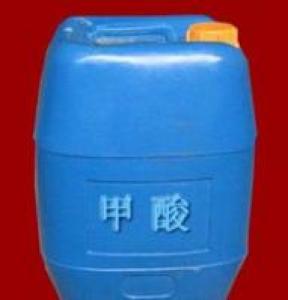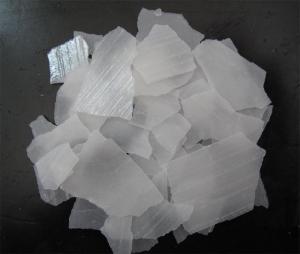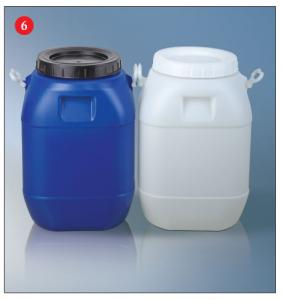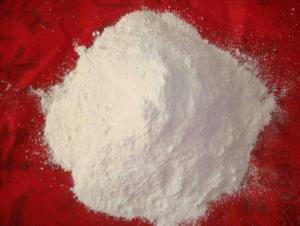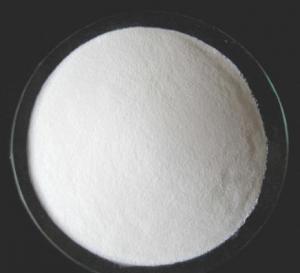Calcium Chloride 74% with High Quality and Comeptitive Price
- Loading Port:
- China Main Port
- Payment Terms:
- TT or LC
- Min Order Qty:
- -
- Supply Capability:
- -
OKorder Service Pledge
OKorder Financial Service
You Might Also Like
1. Structure of Calcium Chloride Description:
Property: White flake or grain crystal, its solubility is strong; Easy to dissolve in water. It has causticity.
Molecular Formula: CaCL2 , CaCL2 .2H2O
Molecule Weight: 110.98 , 147.01
CAS No.: 10043-52-4
Appearance: White Flakes / Ball / Powder/Granular
2.Main Features of Calcium Chloride:
calium chloride anhydrous ,cacl2 74% calcium chloride
Calcium chloride is an inorganic salt, which exists as solid or liquid. Solid calcium chloride is a white, crystal
- General
1) Calcium Chloride :74%Min
2) White flakes
4) Direct manufacturer
5) CAS:10035-04-8
II - Tech Standard: HG/T 2327-2004
III - Application:
1) - Snow melting and de-icing in winter
2) - Dust controlling in road mantenance
3) - Anti-icing and accelerator for concrete
4) - De-inking in paper manufacturing
IV - Packaging: 25kg/bag in a PP woven bag with PE inner liner.or 1000kg/bag(Jumbo bag)
V - Delivery time: 20 days
VI - Production Capacity: 50mt per day
VII - advantage:
1) Most advanced equipment,
2) Good quality(white,not yellowing and little impurity),
3) Most competitive price,
4) Excellent and all-round service
3.Calcium Chloride Images


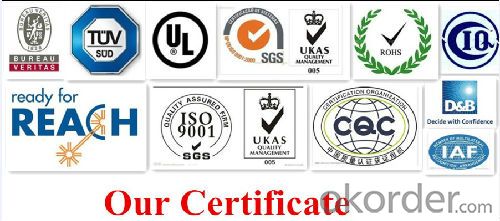
4.Calcium Chloride Specification
Item (Industrial Grade) | Quality Index | |
Purity ( As CaCL 2 ) | 74-77% | 90-94% |
Sulphate ( As CaSO 4 ) | 0.2 % max | 0.2% max |
Magnesium & Alkali Metal Chlorides ( As NaCL) | 3.5% max | 4.0% max |
Alkalinity ( As Ca(OH) 2 ) | 0.2% max | 0.25% max |
Water insoluble | 0.1% max | 0.2% max |
Item (Industrial Grade) | Quality Index | |
Purity ( As CaCL 2 ) | 74-77% | 90-94% |
Sulphate ( As CaSO 4 ) | 0.2 % max | 0.2% max |
Magnesium & Alkali Metal Chlorides ( As NaCL) | 3.5% max | 4.0% max |
Alkalinity ( As Ca(OH) 2 ) | 0.2% max | 0.25% max |
Water insoluble | 0.1% max | 0.2% max |
Arsenic ( As ) | 0.0002% max | 0.0002% max |
Heavy metals ( As Pb ) | 0.0005% max | 0.0005% max |
5.FAQ
1)How many tons does your factory can supply each moth?
30000tons/month
2)How to quarantee the quality of the products?
you can arrange SGS&BV or other quality inspection.
3)How many days you need to pepare the cargo after we made the order?
within 30 days.
- Q: Can inorganic salts be tested by LC / MS?
- LC-MS mass spectrometer for organic matter, inorganic salts can not be atomized not applicable, and will pollute the instrument.
- Q: Why is the residue after burning known as coarse ash? And inorganic salt content What is the difference
- There is no essential difference, the measurement method is different, so the result is different, the former is the burning method, which is the chemical method or instrument method
- Q: Chemical formula The longest inorganic salt
- The primary stage on the salt, acid salt and so on
- Q: Milk food rich in nutrition, in addition to containing a variety of inorganic salts which also contain three types of organic energy can be organic
- Fat Glucose Protein
- Q: Oxide and organic peroxide signs
- An organic compound containing -O-O-peroxy functional group formed by replacing hydrogen atoms in hydrogen peroxide with an organic group such as an alkyl group, an acyl group, an aromatic group or the like. Characterized by heating more than a certain temperature will decompose to produce oxygen free radicals, unstable, easy to break down. Chemical production of organic peroxides is mainly used for synthetic resin polymerization initiator, catalyst. In the field of polymer materials, it can be used as a radical polymerization initiator, graft reaction initiator, rubber and plastic cross-linking agent, unsaturated polyester curing agent and spinning grade polypropylene in the preparation of molecular weight and Molecular weight distribution regulator. Environmental pollution in the air under the action of light through the free radical reaction can produce peroxy nitrates compounds, photochemical oxidants in one of the species. On the skin, eyes, mucous membrane has a strong irritant, is an important pollutant in the atmosphere. Such substances are flammable and explosive dangerous goods, the use should pay attention to safety. Generally, the active oxygen content, activation energy, half-life and decomposition temperature were used as the basis of selection.
- Q: What is the lack of inorganic salts for children?
- Zinc is present in a large number of enzymes, such as carbonic anhydrase, respiratory enzymes, lactic acid dehydrogenic acid, superoxide dismutase, alkaline phosphatase, DNA and RNA polymerase, etc., are nucleic acids, proteins, carbohydrates Synthetic and essential ingredients for the use of vitamin A. With the promotion of growth and development, improve the role of taste. Zinc deficiency occurs when the taste is poor sense of smell, anorexia, slow growth and mental development is lower than normal performance. Zinc can often eat zinc-rich foods: such as protein zinc, oysters, walnuts, egg yolk, seafood and so on.
- Q: Think about the physical and chemical properties of salt and sugar. What properties do these substances have in common? Describe which properties you could use to distinguish between them. What properties and units would you use to describe their physical and chemical characteristics? List as many as you can.
- I believe it's Physical, most of the times such changes are physical, melting point, sublimation, evaporation, etc.
- Q: Recently, when I breathe feeling a bit of acid teeth, this feeling particularly uncomfortable, ask you what is the reason ah? What should I do? Thank you
- What you say is likely to be dentin hypersensitivity because of the lack of enamel, the dentin layer, and the sensation of mechanical irritation, chemical stimulation, and temperature stimulation.
- Q: CO is simple?
- Is pure but not simple
- Q: What is the harm to the human body?
- The disadvantage of soda ash is the vitamin B1, B2 and vitamin C in food have a strong destructive effect, and will affect the body of certain minerals absorption and utilization, and therefore can not be abused.
Send your message to us
Calcium Chloride 74% with High Quality and Comeptitive Price
- Loading Port:
- China Main Port
- Payment Terms:
- TT or LC
- Min Order Qty:
- -
- Supply Capability:
- -
OKorder Service Pledge
OKorder Financial Service
Similar products
Hot products
Hot Searches
Related keywords


